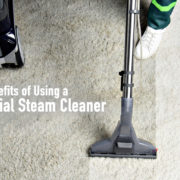In today’s post, you will learn about the health perspective of steam cleaning versus chemical cleaning. We will briefly discuss the benefits and drawbacks of both methods, allowing you to make an informed decision about which option is best for you and your family.
Steam cleaning is a natural and eco-friendly method that uses only heat and water to effectively clean and sanitize surfaces. It eliminates the need for harmful chemicals, making it a healthier option for both you and the environment. Additionally, steam cleaning kills bacteria, viruses, and allergens, which can be especially beneficial for individuals with respiratory conditions or allergies. However, it is important to note that steam cleaning may not be suitable for all surfaces and can result in excess moisture if not done properly.
On the other hand, chemical cleaning uses specific cleaning agents to remove dirt and stains from surfaces. While it can be efficient and effective, there are potential health risks associated with the use of these chemicals. Many cleaning products contain harmful ingredients that can irritate the skin, eyes, and respiratory system. Prolonged exposure or improper use of these chemicals can lead to long-term health issues. Therefore, it is crucial to take necessary precautions when using chemical cleaning products to protect yourself and your loved ones.
In summary, both steam cleaning and chemical cleaning have their pros and cons from a health perspective. Steam cleaning is a natural and eco-friendly option that kills bacteria and allergens, but may not be suitable for all surfaces. Chemical cleaning can be efficient, but it presents potential health risks due to the use of harmful ingredients. Ultimately, the choice between steam cleaning and chemical cleaning depends on your specific needs, preferences, and concerns about health and safety.
Overview of Steam Cleaning and Chemical Cleaning
Definition and purpose of steam cleaning
Steam cleaning is a method of cleaning that uses high-pressure steam to remove dirt, grime, and stains from various surfaces. The process involves heating water to a high temperature, which produces steam that is then applied to the surface being cleaned. The intense heat and pressure of the steam help to dissolve dirt and bacteria, making it an effective and efficient cleaning method.
The purpose of steam cleaning is to provide a deep and thorough clean without the use of harsh chemicals. It is often used as a natural and eco-friendly alternative to traditional cleaning methods that rely on chemical cleaning agents. Steam cleaning can be used on a wide range of surfaces, including floors, carpets, upholstery, tiles, and windows.
Definition and purpose of chemical cleaning
Chemical cleaning, on the other hand, involves the use of cleaning agents that contain chemicals to remove dirt, stains, and bacteria from surfaces. These cleaning agents can vary in composition and strength, depending on the specific cleaning needs. Chemical cleaning is commonly used in various industries, such as hospitality, healthcare, and food processing.
The purpose of chemical cleaning is to effectively remove dirt and stains by breaking down the molecules and bonds that hold them together. Chemical cleaning agents can be highly effective in removing tough stains and disinfecting surfaces. However, they often contain hazardous chemicals that can pose health risks to both humans and the environment.
Comparison between steam cleaning and chemical cleaning
When comparing steam cleaning and chemical cleaning, several factors need to be considered. Steam cleaning offers a natural and eco-friendly solution that does not rely on harmful chemicals. It uses the power of high-pressure steam to effectively clean and sanitize surfaces without leaving behind any residue or toxic fumes.
Chemical cleaning, on the other hand, can be more aggressive in removing tough stains and disinfecting surfaces. However, the use of hazardous chemicals in cleaning agents can pose health risks, especially when not used properly or in well-ventilated areas.
Health Implications of Chemical Cleaning
Hazardous chemicals used in chemical cleaning
Chemical cleaning agents often contain hazardous chemicals such as chlorine, ammonia, and formaldehyde. These chemicals can be toxic when ingested, inhaled, or absorbed through the skin. Prolonged exposure to these chemicals can lead to various health problems, including respiratory issues, skin irritations, eye and throat irritations, and even organ damage.
Health risks associated with exposure to chemical cleaning agents
Exposure to chemical cleaning agents can cause short-term health effects, such as headaches, dizziness, and nausea. In more severe cases, it can lead to respiratory problems, allergies, and asthma attacks. Individuals with pre-existing health conditions, such as asthma or sensitivities to chemicals, are particularly at risk.
Additionally, cleaning staff who are regularly exposed to chemical cleaning agents may be at a higher risk of developing chronic health issues over time. The constant exposure to toxic chemicals can have cumulative effects on their health, potentially leading to long-term respiratory problems and other health complications.
Long-term effects of chemical cleaning on human health
The long-term effects of chemical cleaning on human health are still being studied, but there is growing concern about the potential risks. Some studies have found a link between certain chemicals used in cleaning agents and the development of respiratory diseases, such as asthma and bronchitis, as well as certain types of cancer.
It is important to note that the risks associated with chemical cleaning can be minimized by following proper safety protocols and using adequate ventilation when handling these cleaning agents. However, the potential health risks remain a valid concern, especially for individuals who are exposed to these chemicals on a regular basis.
Advantages of Steam Cleaning
How steam cleaning works
Steam cleaning works by heating water to a high temperature, usually above 200 degrees Fahrenheit, to generate steam. The steam is then applied to the surface being cleaned under high pressure. The heat and pressure of the steam help to dissolve dirt, grease, and grime, making it easier to remove. The steam also sanitizes the surface by killing bacteria and germs.
Eco-friendly nature of steam cleaning
One of the major advantages of steam cleaning is its eco-friendly nature. Steam cleaning does not require the use of harsh chemicals, which means there are no harmful residues left behind. This makes it a safer option for both the environment and the health of individuals using the method.
Additionally, steam cleaning uses significantly less water compared to traditional cleaning methods, making it a more sustainable choice. It also eliminates the need for disposable cleaning cloths or wipes, further reducing waste.
Health benefits of steam cleaning
Steam cleaning offers several health benefits, particularly for individuals with respiratory issues or allergies. The high temperature of the steam helps to kill dust mites, mold, and bacteria, which are common triggers for allergies and respiratory problems. This can create a healthier indoor environment, especially for those who suffer from asthma or other respiratory conditions.
In addition, steam cleaning does not produce any harmful fumes or odors, making it a safer option for individuals with sensitivities to chemicals.
Effectiveness of Steam Cleaning versus Chemical Cleaning
Comparison of cleaning capabilities
When it comes to effectiveness, both steam cleaning and chemical cleaning can deliver satisfactory results. However, the choice between the two methods depends on the specific cleaning needs and the type of surface being cleaned.
Steam cleaning is highly effective in removing dirt, stains, and bacteria from various surfaces. The high-pressure steam can penetrate deep into porous surfaces and cracks, effectively loosening dirt and grime. It is particularly effective in cleaning carpets, upholstery, and hard floors.
Chemical cleaning, on the other hand, can be more aggressive in removing tough stains and disinfecting surfaces. Certain chemicals can break down grease and grime more effectively than steam alone. Chemical cleaning methods are commonly used in commercial settings where deep cleaning and sanitization are required.
Removal of allergens and bacteria
Both steam cleaning and chemical cleaning are effective in removing allergens and bacteria from surfaces. Steam cleaning’s high temperature is especially effective in killing dust mites, mold, and bacteria that can trigger allergies or respiratory issues. The steam penetrates deep into fabrics, carpets, and upholstery, ensuring a thorough clean.
Chemical cleaning agents, when used correctly, can also effectively kill bacteria and sanitize surfaces. However, it is important to note that some chemicals used in cleaning agents may not be as effective against certain types of bacteria or viruses. It is crucial to use the appropriate cleaning agent for specific cleaning needs to ensure the desired level of sanitation.
Eliminating stubborn stains and dirt
When it comes to removing stubborn stains and dirt, chemical cleaning agents can be more effective in certain cases. The chemicals in these cleaning agents are specifically formulated to break down tough stains and dirt. However, it is important to consider the potential health risks associated with the use of these chemicals.
Steam cleaning, on the other hand, may require more time and effort to remove stubborn stains and dirt. However, with the right techniques and equipment, steam cleaning can still provide satisfactory results. It is a safer option for eliminating stains and dirt, especially in households with children or individuals with respiratory issues.
This image is property of images.unsplash.com.
Safety Precautions and Best Practices for Steam Cleaning
Proper handling of steam cleaning equipment
When using steam cleaning equipment, it is important to follow the manufacturer’s instructions and guidelines for proper handling. This includes understanding how to operate the equipment safely and how to prevent accidents or injuries.
Some key safety measures include wearing appropriate protective gear, such as gloves and safety goggles, to protect against hot steam and potential splashes. It is also important to ensure that the steam cleaning equipment is in good working condition, with no leaks or malfunctions that could pose a safety risk.
Protective gear and safety measures
In addition to wearing appropriate protective gear, such as gloves and safety goggles, there are other safety measures that should be followed when using steam cleaning equipment. It is important to keep the steam cleaning equipment away from children and pets to prevent accidents. The steam can cause burns if not used properly or if it comes into contact with the skin.
It is also important to operate the steam cleaning equipment in a well-ventilated area to prevent the accumulation of steam and moisture. This helps to reduce the risk of slips and falls due to wet surfaces, as well as minimize the potential for mold or mildew growth.
Preventing accidents and injuries
To prevent accidents and injuries, it is important to use steam cleaning equipment in a responsible and safe manner. This includes being aware of potential hazards, such as electrical cords or furniture that could pose a tripping hazard. It is also important to avoid spraying steam directly onto electrical outlets or appliances to prevent electrical shocks.
Proper training and familiarization with the steam cleaning equipment can also help minimize the risk of accidents or injuries. Understanding the limitations and capabilities of the equipment can prevent misuse and potential damage to surfaces or belongings.
Cost Considerations of Steam Cleaning versus Chemical Cleaning
Initial investment for steam cleaning equipment
The cost of steam cleaning equipment can vary depending on the size and capabilities of the machine. High-quality steam cleaning machines can range from a few hundred dollars to several thousand dollars. The initial investment may be higher compared to traditional cleaning equipment, but it can provide long-term cost savings by eliminating the need for chemical cleaning agents.
Cost of chemicals used in chemical cleaning
Chemical cleaning agents can also vary in cost, depending on the type and brand. Some cleaning agents may be more expensive than others, especially if they are specialized for certain industries or specific cleaning needs. The cost of chemicals can add up, particularly for businesses that require regular cleaning and sanitization.
It is important to consider the ongoing cost of chemicals when comparing the overall cost-effectiveness of steam cleaning versus chemical cleaning.
Long-term cost-effectiveness analysis
When analyzing the long-term cost-effectiveness of steam cleaning versus chemical cleaning, it is important to consider the overall costs involved. While the initial investment for steam cleaning equipment may be higher, the savings in chemical cleaning agents over time can offset the cost.
Additionally, steam cleaning equipment requires less frequent replacement compared to chemical cleaning equipment. This further enhances the cost-effectiveness of steam cleaning in the long run. It is important to weigh the upfront costs against the potential savings and benefits of using steam cleaning as a sustainable and eco-friendly option.
This image is property of images.unsplash.com.
Environmental Impact of Steam Cleaning versus Chemical Cleaning
Pollution caused by chemical cleaning agents
Chemical cleaning agents can have a negative impact on the environment. When these chemicals are washed down the drain or disposed of improperly, they can contaminate water sources and harm aquatic life. Additionally, the production and manufacturing of these chemicals can contribute to air and water pollution during their lifecycle.
The use of harmful chemicals in cleaning agents can also contribute to indoor air pollution, especially in poorly ventilated areas. The release of volatile organic compounds (VOCs) from these cleaning agents can worsen indoor air quality and pose health risks to individuals in the vicinity.
Steam cleaning as a sustainable alternative
Steam cleaning offers a more sustainable alternative to chemical cleaning. It does not contribute to water pollution since it uses minimal water compared to traditional cleaning methods. The high temperature of the steam also helps to kill bacteria and germs without the need for harsh chemicals.
Furthermore, steam cleaning eliminates the need for disposable cleaning cloths or wipes, reducing waste and minimizing the environmental footprint. It is a more environmentally friendly option that promotes sustainable practices in cleaning and maintenance.
Reducing carbon footprint with steam cleaning
In addition to its eco-friendly nature, steam cleaning can also help reduce carbon emissions. By eliminating the use of chemical cleaning agents, steam cleaning reduces the energy consumption and carbon emissions associated with their production, transportation, and disposal.
Switching to steam cleaning not only minimizes the environmental impact but also contributes to a greener and more sustainable future. It is a step towards reducing reliance on harmful chemicals and adopting cleaner and more responsible cleaning practices.
Applications of Steam Cleaning and Chemical Cleaning
Suitable surfaces for steam cleaning
Steam cleaning can be used on a wide range of surfaces, including but not limited to:
- Hard floors such as hardwood, laminate, tile, and vinyl
- Carpets and rugs
- Upholstery and fabric
- Glass and mirrors
- Kitchen appliances and surfaces
- Bathroom fixtures and tiles
- Windows and blinds
- Outdoor furniture and surfaces
Chemical cleaning is commonly used in industries such as hospitality, healthcare, and food processing. It is suitable for surfaces that require deep cleaning, sanitization, and disinfection. The specific types of chemicals used may vary depending on the industry and cleaning needs.
Specific industries and sectors benefitting from chemical cleaning
Chemical cleaning is widely used in healthcare facilities to maintain cleanliness and prevent the spread of infections. It is also common in hospitality settings, such as hotels and restaurants, where high standards of cleanliness and sanitization are required. Additionally, the food processing industry relies on chemical cleaning to ensure food safety and prevent cross-contamination.
Chemical cleaning is also used in industrial settings, such as manufacturing plants and warehouses, where heavy machinery and equipment need to be thoroughly cleaned and maintained. Each industry may have specific regulations and guidelines regarding the use of chemical cleaning agents to ensure safety and compliance.
Determining the appropriate cleaning method for different scenarios
When determining the appropriate cleaning method for different scenarios, it is important to consider several factors, including the type of surface, the cleaning needs, and the desired outcomes. Steam cleaning is generally a safe and effective option for most household cleaning needs. However, chemical cleaning may be necessary in certain industries or situations where deep cleaning and sanitization are critical.
Consulting with professionals or following industry guidelines can help determine the most suitable cleaning method for specific scenarios. It is essential to prioritize health, safety, and environmental considerations when making cleaning decisions.
Guidelines for Choosing Between Steam Cleaning and Chemical Cleaning
Considering health implications
When choosing between steam cleaning and chemical cleaning, it is crucial to consider the health implications. Steam cleaning offers a safer and healthier alternative by eliminating the use of harmful chemicals. It minimizes the risk of exposure to toxic fumes and reduces the potential for health issues associated with chemical cleaning agents.
Individuals with respiratory conditions or sensitivities to chemicals may benefit from steam cleaning, as it helps to create a healthier indoor environment. However, it is essential to weigh the cleaning needs and desired outcomes against the potential benefits and limitations of each method.
Assessing cleaning needs and desired outcomes
Assessing the cleaning needs and desired outcomes is an important step in choosing the most appropriate cleaning method. Steam cleaning is effective in removing dirt, stains, and bacteria from a wide range of surfaces. However, it may require more time and effort to remove stubborn stains compared to chemical cleaning.
Chemical cleaning, on the other hand, can provide more aggressive cleaning and sanitization, particularly in commercial or industrial settings. However, the potential health risks associated with the use of chemical cleaning agents need to be carefully considered.
Consulting with professionals for expert advice
When in doubt about the most suitable cleaning method for specific scenarios, it is advisable to consult with professionals or seek expert advice. Professional cleaning services can provide insights on the most effective and safe cleaning methods for different surfaces and environments. They can also recommend specific products or techniques that meet the desired cleaning needs.
Professional advice can help ensure that cleaning decisions are based on accurate information and expertise. It can also provide peace of mind knowing that the chosen cleaning method aligns with health, safety, and environmental considerations.
Conclusion
In conclusion, when choosing between steam cleaning and chemical cleaning, it is important to consider the health implications, effectiveness, safety, costs, and environmental impact. Steam cleaning offers a natural and eco-friendly alternative that minimizes the potential health risks associated with chemical cleaning agents. It is effective in removing dirt, stains, and bacteria from various surfaces, providing a deep and thorough clean.
Chemical cleaning, while effective in certain scenarios, can pose health risks due to the hazardous chemicals used in cleaning agents. Prolonged exposure to these chemicals can lead to respiratory issues, allergies, and long-term health complications. The ongoing cost of chemicals and their impact on the environment should also be taken into account.
Making an informed decision about the most appropriate cleaning method is crucial. Assessing the cleaning needs, considering health implications, and consulting with professionals can help ensure that the chosen method aligns with desired outcomes and promotes health, safety, and sustainability. By prioritizing health and adopting sustainable cleaning practices, both individuals and the environment can benefit from a safer and cleaner living or working environment.





